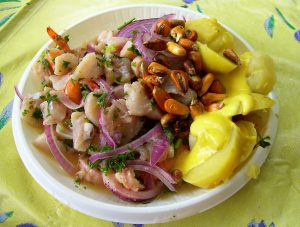GBL 101
Andreia Pena-Lopes
Ceviche-Peru
 https://commons.wikimedia.org/wiki/File:Ceviche_with_cancha_at_Peruvian_Market,_Caracas.jpg
https://commons.wikimedia.org/wiki/File:Ceviche_with_cancha_at_Peruvian_Market,_Caracas.jpg
In the spring I will have the chance to travel to Peru for my Journeys trip. My father is peruvian and it will be the first time I will be able to visit and experience this journey. I am in love with everything about the peruvian culture especially their foods. While one of my favorite dishes that my father makes for my family is Ceviche. When making Ceviche you can vary what specific seafood you want to use but the popular seafood used is a mixture of shrimp, raw fish, scallops, or squid marinated in a lime and pepper mixture it is considered to be one of the biggest national dishes due to its popularity. When Ceviche is eaten often it is served with a variety of things such as corn-on-the-cob, cancha which is toasted corn, or sweet potatoes. Peru continues to become a gastronomical capital of Latin America and has done so on the back of their favorite dish, ceviche. Ceviche is one of the biggest highlights to Peruvian dishes.
The history of Peruvian food comes from the Incas. Inca Empire had access to abundant amounts of fish and shellfish during their time. The dish originally was first marinated with “chicha”, juice that comes from maize meaning corn. It is said that Ceviche evolved from a dish that was brought to Peru by Spanish conquistadors. When the Spaniards arrived with lime and onion from the Mediterranean then that was used to marinade the fish. The Incas used a variety of their dishes based on seafood, corn, potatoes, and much more. While many of Peruvian dishes are all served with one or the other, Peruvian climate and landscapes allow a variety of these dishes in South America. Peru being one of the largest countries in South America all the water around Peru plays a big environmental impact for their traditional dishes. The Pacific Ocean is a key provider to Peruvian dishes, with a huge variety of seafood, particularly for those who live near the coast.
Lima, Peru is one of the main places to find Ceviche. Many tourists make sure to try Ceviche when visiting Lima. Ceviche is considered Lima’s “dish of the city”. Ceviche being one of the biggest traditional dishes, the Peruvian government created in 2008 National Ceviche Day to honor the importance of Ceviche as part of Peru’s national heritage. This day is celebrated every year on June 28th. Ceviche can be found in a variety of places from a local small restaurant, big fancy restaurants, and even a local market. In the gastronomy capital of Lima, Peru, often you can find very high-end restaurant offering meals for five to ten times the prices of a meal offered in the market. Farmers market play a huge impact on not only Ceviche but many other Peruvian dishes. The farmers markets in Peru provide not only authentic products for these traditional dishes but are great places to learn about the vegetables and fruits that grow in Peru, they are also great spots to enjoy authentic meals like Ceviche.
Fish plays a huge impact in the economy in Peru. In Peru, averagely a person eats 44 pounds of fish every year compared to just 16 pounds in the U.S. This makes fish a huge target for markets and restaurants to sell seafood because of the amount eaten in Peru. Lima typically costs between S/.5 and S/.15 nuevos soles (US$1.80 to $5.40). The prices can vary from where you go to each these common traditional dishes.
Ceviche is continuing to grow throughout South America and is prepared differently in countries like Ecuador, Mexico, Panama, and Chile due to its increasing spread throughout Latin America it has now become more popular in restaurants in Europe as well as the United States. I have tried Ceviche in many restaurants here in the United States but am excited to be able to try real authentic Ceviche in my trip to Peru.
